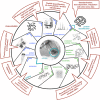A decade of metaproteomics: where we stand and what the future holds
- PMID: 26315987
- PMCID: PMC5049639
- DOI: 10.1002/pmic.201500183
A decade of metaproteomics: where we stand and what the future holds
Abstract
We are living through exciting times during which we are able to unravel the "microbial dark matter" in and around us through the application of high-resolution "meta-omics". Metaproteomics offers the ability to resolve the major catalytic units of microbial populations and thereby allows the establishment of genotype-phenotype linkages from in situ samples. A decade has passed since the term "metaproteomics" was first coined and corresponding analyses were carried out on mixed microbial communities. Since then metaproteomics has yielded many important insights into microbial ecosystem function in the various environmental settings where it has been applied. Although initial progress in analytical capacities and resulting numbers of proteins identified was extremely fast, this trend slowed rapidly. Here, we discuss several representative metaproteomic investigations of activated sludge, acid mine drainage biofilms, freshwater and seawater microbial communities, soil, and human gut microbiota. By using these case studies, we highlight current challenges and possible solutions for metaproteomics to realize its full potential, i.e. to enable conclusive links between microbial community composition, physiology, function, interactions, ecology, and evolution in situ.
Keywords: Integrated omics; Metagenomics; Metaproteomics; Microbial community; Microbial systems ecology; Microbiology.
© 2015 The Authors. PROTEOMICS published by Wiley-VCH Verlag GmbH & Co. KGaA, Weinheim.
Figures

References
-
- Armengaud, J. , Marie Hartmann, E. , Bland, C. , Proteogenomics for environmental microbiology. Proteomics 2013, 13, 2731–2742. - PubMed
-
- Wilmes, P. , Bond, P. L. , The application of two‐dimensional polyacrylamide gel electrophoresis and downstream analyses to a mixed community of prokaryotic microorganisms. Environ. Microbiol. 2004, 6, 911–920. - PubMed
-
- Ram, R. J. , Verberkmoes, N. C. , Thelen, M. P. , Tyson, G. W. et al., Community proteomics of a natural microbial biofilm. Science 2005, 308, 1915–1920. - PubMed
-
- Daims, H. , Taylor, M. W. , Wagner, M. , Wastewater treatment: a model system for microbial ecology. Trends Biotechnol. 2006, 24, 483–489. - PubMed
MeSH terms
Substances
LinkOut - more resources
Full Text Sources
Other Literature Sources

